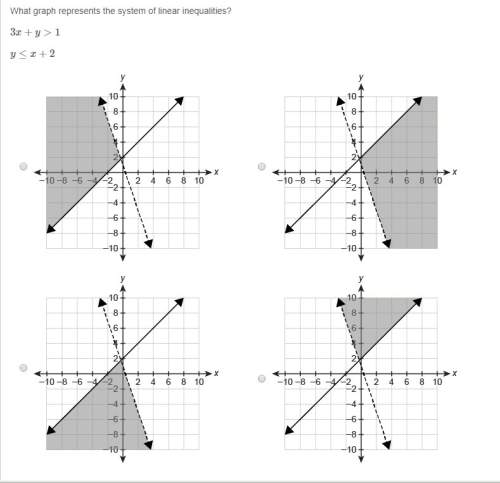Area: Change in Dimensions
A rectangle FGHJ has a width of 3 inches and a length of 7 inches
...

Mathematics, 15.07.2021 20:50 anonymous8888
Area: Change in Dimensions
A rectangle FGHJ has a width of 3 inches and a length of 7 inches
a) What is the Area of the rectangle?
b) What is the Area of the new rectangle if you double the width of FDHJ? How did you find it? How much bigger or smaller did the new Area get?
c) What is the Area of the new rectangle if you double the width and length of rectangle FDHJ? How did you find it? How much bigger or smaller did the new Area get
compared to the area of FDHJ?
d) Now choose a different shape of your liking and give it your own dimensions. Answer questions a), b), c) and d) for the shape you chose.
e) Can you generalize what happens if you change one of the dimensions of a shape and what happens when you change both dimensions of the shape?


Answers: 2


Another question on Mathematics

Mathematics, 21.06.2019 21:30
The perimeter of a rectangular lot of land is 436 ft. this includes an easement of x feet of uniform width inside the lot on which no building can be done. if the buildable area is 122 ft by 60 ft, determine the width of the easement. select one: a. 9 feet b. 18 feet c. 4.5 feet d. 7 feet
Answers: 3

Mathematics, 21.06.2019 21:40
Scores on the cognitive scale of the bayley-scales of infant and toddler development range from 1 to 19, with a standard deviation of 3. calculate the margin of error in estimating the true mean cognitive scale score, with 99% confidence, if there are 12 infants and toddlers in a sample.
Answers: 3


Mathematics, 21.06.2019 23:30
Determine if the following statement is true or false. the normal curve is symmetric about its​ mean, mu. choose the best answer below. a. the statement is false. the normal curve is not symmetric about its​ mean, because the mean is the balancing point of the graph of the distribution. the median is the point where​ 50% of the area under the distribution is to the left and​ 50% to the right.​ therefore, the normal curve could only be symmetric about its​ median, not about its mean. b. the statement is true. the normal curve is a symmetric distribution with one​ peak, which means the​ mean, median, and mode are all equal.​ therefore, the normal curve is symmetric about the​ mean, mu. c. the statement is false. the mean is the balancing point for the graph of a​ distribution, and​ therefore, it is impossible for any distribution to be symmetric about the mean. d. the statement is true. the mean is the balancing point for the graph of a​ distribution, and​ therefore, all distributions are symmetric about the mean.
Answers: 2
You know the right answer?
Questions





Arts, 21.09.2019 05:40



Mathematics, 21.09.2019 05:40

History, 21.09.2019 05:40

Mathematics, 21.09.2019 05:40

History, 21.09.2019 05:40





Business, 21.09.2019 05:40

Mathematics, 21.09.2019 05:40


Geography, 21.09.2019 05:40





